THIS week we present another of Paul Bissell’s covers for Flying Aces! Bissell is mainly known for doing the covers of Flying Aces from 1931 through 1934 when C.B. Mayshark took over duties. For the July 1932 cover Bissell put us right in the action as Lieutenant Charles Nungesser surprises a flight of German Hell hawks!
Nungesser to the Rescue!
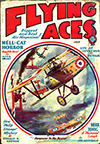 IT WAS a hazy morning in December of ’16. The sun struggled to break through the heavy fog which had for days now hung close to the sodden landscape. Here and there were patches of snow, but in general the land was all half-frozen mud. The armies of the Allies and the Germans had dug themselves in for the winter, satisfied, except for an occasional almost individual effort, merely to hold what they had, fortify themselves against attack, and await spring for offensive movements.
IT WAS a hazy morning in December of ’16. The sun struggled to break through the heavy fog which had for days now hung close to the sodden landscape. Here and there were patches of snow, but in general the land was all half-frozen mud. The armies of the Allies and the Germans had dug themselves in for the winter, satisfied, except for an occasional almost individual effort, merely to hold what they had, fortify themselves against attack, and await spring for offensive movements.
On a French airdrome just a few kilometers back of the lines several ships were being groomed to take off. Motors were warmed up and impatient pilots looked constantly up at the sky, waiting for the fog to clear away. Finally a small Nieuport took off, circling the field and climbing away rapidly, soon to be lost in the mist. On the wings was the tri-color cocarde of the French. On the fuselage was painted a curious insignia. On a black heart was imposed a white skull and crossbones, above which was a coffin with a lighted candle at either end, and to one side was featured in large figures the number 13.
This was the plane of Lieutenant Charles Nungesser, a pilot who, even at this early date in the war, was already an ace, and whose daring and aggressiveness were to lead him into numberless air battles, gain for him the credit of forty-five victories against his adversaries, and leave him, at the end of the war, with more wounds than any living aviator. He fought always for the glory of France, with a recklessness and abandon that did not take into consideration any thought of personal safety. To him days that he could not fly were days wasted. He chafed with impatience when bad weather or wounds kept him from the skies and his eager search for the enemy.
For days now Nungesser had been held down to earth by the bad weather and restlessly he had waited for the sun to break through, until, when telephonic advices from up and down the line told him that the weather was clearing, he took off into the mist rather than wait longer for it to lift.
He was not a thousand feet up when he went into a cloud bank, and, nosing the little machine up slightly, he headed in the general direction of Metz, flying solely by his compass and instinct. All around was gray mist. There was no top, no bottom, just one moist, gray evenness all around. Only the “feel†of his seat told him whether he was climbing, level, or banked over.
Steadily he gained altitude, his windshield running little streams of water, his whole plane glistening wet from the gray mist. Ten, fifteen minutes he climbed; his altimeter now showed twelve thousand feet when suddenly he burst from the grayness into the blazing sunlight. Above him, now, was only the limitless blue, below the great billowy clouds formed an irregular floor, dazzling white in the sunshine, with brilliant blup shadows.
IT WAS some seconds before he could adjust his eyes to the sudden brilliance. Then, off to the left, he made out four planes, mere specks against the horizon. Placing the sun behind him, and still climbing, slowly he gained on them, and before long made them out to be four German Halberstadt scouts. He was now fifty miles north of his airdrome, and the cloud formations were beginning to break up. Great holes in them showed, far below, the woods of Valluber, splotched with sunlight and shadow.
Just east of Lechelle he saw the four scouts suddenly turn over on their noses and go diving through one of these openings. His first thought was that they were simply diving to get below the clouds, but a second glance showed him the reason of their plunge. A British Caudron artillery observation plane was flying calmly below, unaware of the death and destruction hurtling toward it.
A push forward on the wheel and the little Nieuport nosed over, motor full on, roaring in pursuit of the diving Germans. The British pilot, now aware of his danger, banked around sharply, avoiding the first German plane, which flashed by and turned in a wide spiral to renew the attack. The second German, diving with guns blazing, was forced to change his course to avoid the deadly fire that the British observer poured out on him.
Nungesser, as yet unobserved, banked over to keep “in the sun†and be ready for the first German as he turned back to dive at the Caudron. Easing back on his wheel to hold his elevation, he got himself directly in position, counting on the fact that because of the sun at his back he would be unseen by the German, now up on his wingtip, twisting as he turned for his second attack. Over again went the Nieuport’s nose, on went the motor full, and carefully Nungesser guided his headlong flight until at last he saw the German’s tail creep between his sights. A little more and the Boche pilot himself was full in line with the Frenchman’s guns. A squeeze of the trigger and a tracer bullet proved the aim was true. Then a full burst. The German, caught unawares, half-turned in his seat as the bullets spat around him. His arm jerked up sharply as he was hit. Helplessly he attempted to evade the diving Frenchman. He veered off to the left, but his move was anticipated by Nungesser, and another burst, this time into his gas tank, finished the show.
A puff of smoke, then a burst of flame, and the doomed Halberstadt plunged downward, twisting and turning, leaving a trail of smoke behind.
A sharp renversement and Nungesser was back to the defense of the slow-moving Caudron. The Germans, however, seeing their leader go down in flames, had had enough, and were already streaking it for home.

“Nungesser to the Rescue!â€
Flying Aces, July 1932 by Paul J. Bissell
IT WAS ten years later, and again the day was gray. Again a ship stood impatiently at a French airdrome. It was a larger ship this time, a ship carrying untold gallons of gasoline to enable it in one flight to span an ocean. A ship all white, but on its fuselage was again painted that strange insignia, a white skull and crossbones on a black heart. It was scarcely daybreak, but a crowd had collected. Word had gone around that Nungesser and Coli were about to start.
For days and weeks they had waited impatiently on the ground for conditions which would give them at least a chance of success. On the other side of the Atlantic, groomed and ready, other planes were waiting to make this same attempt from the west. No time could be lost if Nungesser was to.gain for his beloved country the honor of the first successful flight between France and America. The telegraph clicked, word was flashed that the weather over the Atlantic seemed favorable, or at least as favorable as they might hope for. The chance must be taken.
Quick orders were given. The motor, already warmed, was again tested. Last-minute directions and dispatches were given, and farewells spoken. Two men climbed into the cockpit. All was ready. A face leaned out of the cabin, a hand went up in a waved farewell to the crowd. The chocks were pulled, and the plane started down the runway. A moment later, and the great White Bird, staggering under its weight of gasoline, rose into the air, and Nungesser, one of France’s great air heroes, had started on his last flight.
Twenty hours had passed. Once again a plane struggled in the dense nothingness of the fog. A pilot who had come victorious through many air battles against the Germans was now at death grips with the elements themselves. A missing motor, wings heavily laden with ice, fuel low, and a storm-whipped sea beneath. The last grim secrets of that brave flight have been hidden forever.
On the night of Nungesser’s fateful flight there was on the west shore of the Atlantic a British ex-war pilot who owed his life to the French ace, a pilot who waited anxiously for word of the White Bird’s safe arrival, waited anxiously and waited in vain. And there is a legend that on a high cliff of the bleak Newfoundland coast there is a small stone that looks ever out toward sea. It has no name, and bears but two words, “In Memory.†And carved deep in the solid granite slab is once again that strange insignia—a skull and crossbones on a heart.
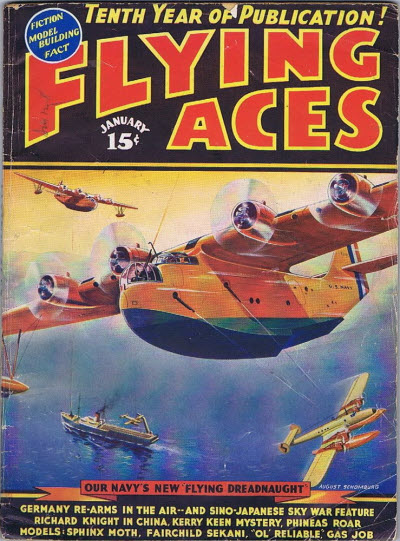 That sound can only mean one thing—that Bachelor of Artifice, Knight of Calamity and an alumnus of Doctor Merlin’s Camelot College for Conjurors is back to vex not only the Germans, but the Americans—the Ninth Pursuit Squadron in particular—as well. Yes it’s the marvel from Boonetown, Iowa himself—Lieutenant Phineas Pinkham!
That sound can only mean one thing—that Bachelor of Artifice, Knight of Calamity and an alumnus of Doctor Merlin’s Camelot College for Conjurors is back to vex not only the Germans, but the Americans—the Ninth Pursuit Squadron in particular—as well. Yes it’s the marvel from Boonetown, Iowa himself—Lieutenant Phineas Pinkham! 




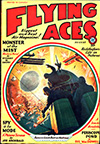
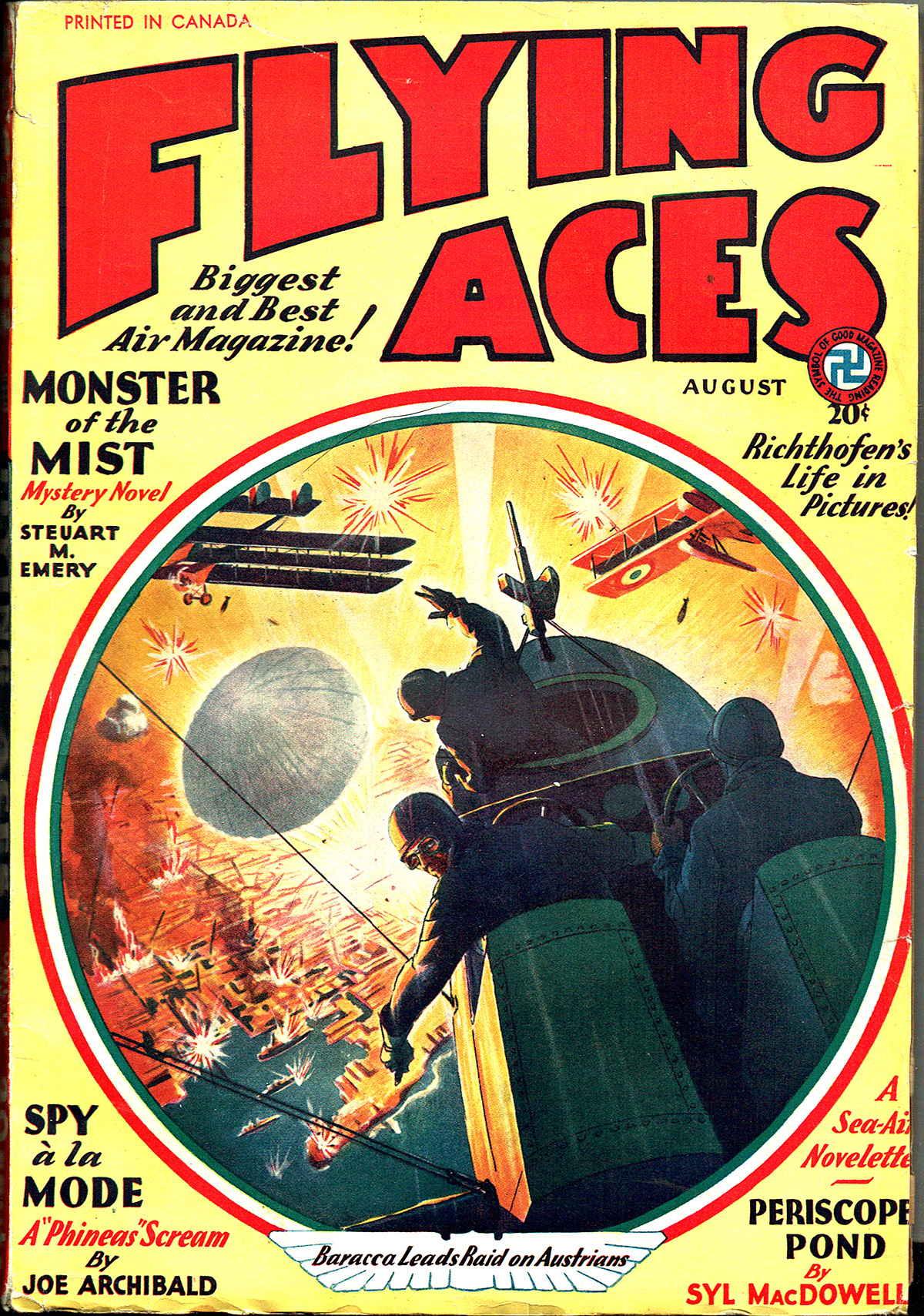
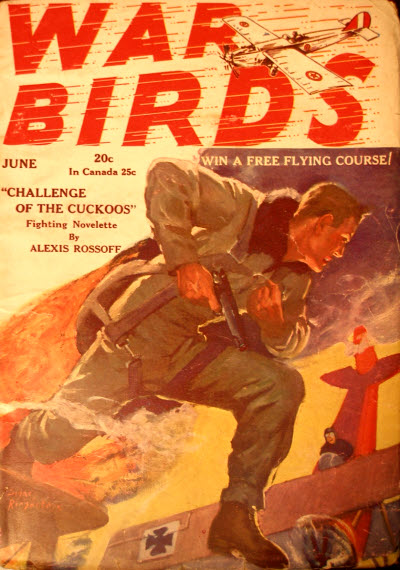 tale of the Cuckoo’s Nest from the prolific pen of Alexis Rossoff. The Cuckoo’s Nest stories ran in War Birds in 1930. The Cuckoo’s are an outfit a lot like Keyhoe’s
tale of the Cuckoo’s Nest from the prolific pen of Alexis Rossoff. The Cuckoo’s Nest stories ran in War Birds in 1930. The Cuckoo’s are an outfit a lot like Keyhoe’s 
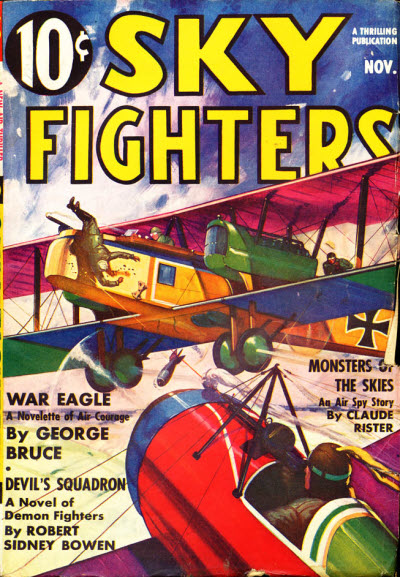 a story from the highly prolific George Bruce. Bruce, a former pilot, began writing in the 1920’s and became noted for his aerial war stories—several publications even bore his name. In the 1930’s and ’40’s he transitioned into screenwriting for Hollywood action films and then into tv in the 1950’s and ’60’s.
a story from the highly prolific George Bruce. Bruce, a former pilot, began writing in the 1920’s and became noted for his aerial war stories—several publications even bore his name. In the 1930’s and ’40’s he transitioned into screenwriting for Hollywood action films and then into tv in the 1950’s and ’60’s.



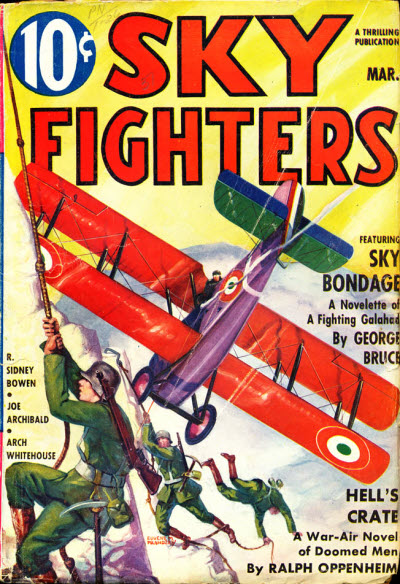 a short, but gripping tale from the prolific pen of
a short, but gripping tale from the prolific pen of